Frame AI raises $6.3M Series A to help understand customers across channels
Frame AI, a New York City startup that uses artificial intelligence and machine learning to help companies understand their customers better across multiple channels, announced a $6.3 million Series A investment today.
G20 Ventures and Greycroft led the round together. Bill Wiberg, co-founder and partner at G20, will join Frame’s board under the terms of the deal. The total raised with an earlier seed round is over $10 million, according to the company.
“Frame is basically an early warning system and continuous monitoring tool for your customer voice,” Frame CEO and co-founder George Davis told TechCrunch . What that means, in practice, is the tool plugs into help desk software, call center tooling, CRM systems and anywhere else in a company that communicates with a customer.
“We then use natural language understanding to pull out emerging themes and basically aggregate them to account and segment levels so that customer experience leaders can prioritize taking actions to improve their relationships,” Davis explained.
He believes that customer experience leaders are being asked to do more and more in terms of talking to customers on ever more channels and digesting that into useful information for the rest of their company to be responsive to customer needs, and he says that there isn’t a lot of tooling to help with this particular part of the customer experience problem.
“We don’t think they have the right tools to do either the listening in the first place or the analysis. We’re trying to make it possible for them to hear their customers everywhere they’re already talking to them, and then act on that information,” he said.
He says they work alongside customer data platforms (CDPs) like Segment, Salesforce Customer 360 and Adobe Real-time CDP. “We can take the customer voice information from all of these unstructured sources, all these natural language sources and turn it into moments that can be contributed back to one of these structured data platforms.”
Davis certainly recognizes that his company is getting this money in the middle of a health and economic crisis, and he hopes that a tool like his that can help take the pulse of the customer across multiple channels can help companies succeed at a time when a data-driven approach to customer experience is more important than ever.
He says that by continuing to hire through this and building his company, he can contribute to restarting the economic engine, even if in some small way.
“It’s a bleak time, but I have a lot of confidence in New York and in the country, in the customer experience community and in the world’s ability to bounce back strong from this. I think it’s actually created a lot of solidarity that we’re all going to find a lot of new opportunities, and we’re going to just keep building Frame as fast as we can.”
Powered by WPeMatico
Digital mapping of coronavirus contacts will have key role in lifting Europe’s lockdown, says Commission
The European Commission has set out a plan for coordinating the lifting of regional coronavirus restrictions that includes a role for digital tools in what the EU executive couches as “a robust system of reporting and contact tracing.” However it has reiterated that such tools must “fully respect data privacy.”
Last week, the Commission made a similar call for a common approach to data and apps for fighting the coronavirus, emphasizing the need for technical measures to be taken to ensure that citizens’ rights and freedoms aren’t torched in the scramble for a tech fix.
Today’s toolbox of measures and principles is the next step in its push to coordinate a pan-EU response.
“Responsible planning on the ground, wisely balancing the interests of protection of public health with those of the functioning of our societies, needs a solid foundation. That’s why the Commission has drawn up a catalogue of guidelines, criteria and measures that provide a basis for thoughtful action,” said EC president Ursula von der Leyen, commenting on the full roadmap in a statement.
“The strength of Europe lies in its social and economic balance. Together we learn from each other and help our European Union out of this crisis,” she added.
Harmonized data gathering and sharing by public health authorities — “on the spread of the virus, the characteristics of infected and recovered persons and their potential direct contacts” — is another key plank of the plan for lifting coronavirus restrictions on citizens within the 27 Member State bloc.
While ‘anonymized and aggregated’ data from commercial sources — such as telcos and social media platforms — is seen as a potential aid to pandemic modelling and forecasting efforts, per the plan.
“Social media and mobile network operators can offer a wealth of data on mobility, social interactions, as well as voluntary reports of mild disease cases (e.g. via participatory surveillance) and/or indirect early signals of disease spread (e.g. searches/posts on unusual symptoms),” it writes. “Such data, if pooled and used in anonymised, aggregated format in compliance with EU data protection and privacy rules, could contribute to improve the quality of modelling and forecasting for the pandemic at EU level.”
The Commission has been leaning on telcos to hand over fuzzy metadata for coronavirus modelling which it wants done by the EU’s Joint Research Centre. It wrote to 19 mobile operators last week to formalize its request, per Euractiv, which reported yesterday that its aim is to have the data exchange system operational ‘as soon as possible’ — with the hope being it will cover all the EU’s member states.
Other measures included in the wider roadmap are the need for states to expand their coronavirus testing capacity and harmonize tesing methodologies — with the Commission today issuing guidelines to support the development of “safe and reliable testing”.
Steps to support the reopening of internal and external EU borders is another area of focus, with the executive generally urging a gradual and phased lifting of coronavirus restrictions.
On contacts tracing apps specifically, the Commission writes:
“Mobile applications that warn citizens of an increased risk due to contact with a person tested positive for COVID-19 are particularly relevant in the phase of lifting containment measures, when the infection risk grows as more and more people get in contact with each other. As experienced by other countries dealing with the COVID-19 pandemic, these applications can help interrupt infection chains and reduce the risk of further virus transmission. They should thus be an important element in the strategies put in place by Member States, complementing other measures like increased testing capacities.
“The use of such mobile applications should be voluntary for individuals, based on users’ consent and fully respecting European privacy and personal data protection rules. When using tracing apps, users should remain in control of their data. National health authorities should be involved in the design of the system. Tracing close proximity between mobile devices should be allowed only on an anonymous and aggregated basis, without any tracking of citizens, and names of possibly infected persons should not be disclosed to other users. Mobile tracing and warning applications should be subject to demanding transparency requirements, be deactivated as soon as the COVID-19 crisis is over and any remaining data erased.”
“Confidence in these applications and their respect of privacy and data protection are paramount to their success and effectiveness,” it adds.
Earlier this week Apple and Google announced a collaboration around coronavirus contracts tracing — throwing their weight behind a privacy-sensitive decentralized approach to proximity tracking that would see ephemeral IDs processed locally on devices, rather than being continually uploaded and held on a central server.
A similar decentralized infrastructure for Bluetooth-based COVID-19 contacts tracing had already been suggested by a European coalition of privacy and security experts, as we reported last week.
While a separate coalition of European technologists and researchers has been pushing a standardization effort for COVID-19 contacts tracing that they’ve said will support either centralized or decentralized approaches — in the hopes of garnering the broadest possible international backing.
For its part the Commission has urged the use of technologies such as decentralization for COVID-19 contacts tracing to ensure tools align with core EU principles for handling personal data and safeguarding individual privacy, such as data minimization.
However governments in the region are working on a variety of apps and approaches for coronavirus contacts tracing that don’t all look as if they will check a ‘rights respecting’ box…
Poland advertised a new product to enforce #coronavirus #COVID19 quarantaine? Electronic bracelet equipped with geolocation sensor (and a microphone, apparently), for “constant monitoring instead of random checks”. https://t.co/WipDJDnLK8 pic.twitter.com/ormYjM1EyJ
— Lukasz Olejnik (@lukOlejnik) April 14, 2020
In a video address last week, Europe’s lead privacy regulator, the EDPS, intervened to call for a “panEuropean model ‘COVID-19 mobile application’, coordinated at EU level” — in light of varied tech efforts by Member States which involve the processing of personal data for a claimed public health purpose.
“The use of temporary broadcast identifiers and bluetooth technology for contact tracing seems to be a useful path to achieve privacy and personal data protection effectively,” said Wojciech Wiewiórowski on Monday week. “Given these divergences, the European Data Protection Supervisor calls for a panEuropean model “COVID-19 mobile application”, coordinated at EU level. Ideally, coordination with the World Health Organisation should also take place, to ensure data protection by design globally from the start.”
The Commission has not gone so far in today’s plan — calling instead for Member States to ensure their own efforts align with the EU’s existing data protection framework.
Though its roadmap is also heavy on talk of the need for “coordination between Member States, to avoid negative effects” — dubbing it “a matter of common European interest”. But, for now, the Commission has issued a list of recommendations; it’s up to Member States to choose to fall in behind them or not.
With the caveat that EU regulators are watching very carefully how states’ handle citizens’ data.
“Legality, transparency and proportionality are essential for me,” warned Wiewiórowski, ending last week’s intervention on the EU digital response to the coronavirus with a call for “digital solidarity, which should make data working for all people in Europe and especially for the most vulnerable” — and a cry against “the now tarnished and discredited business models of constant surveillance and targeting that have so damaged trust in the digital society”.
Powered by WPeMatico
Adriel brings automation to small business advertising
Adriel is a South Korean startup bringing automated ad tools to small businesses — and in recent months, it’s been expanding into the United States and the United Kingdom.
This might seem like exactly the wrong time to be growing an ad-buying platform, since we’re at the beginning of what’s likely to be a tremendous pullback in ad spend due to the COVID-19 pandemic. However, co-founder and CEO Sophie Eom told me via email that ad spend on Adriel increased by 7% in February, then by 6% in March, and she estimated that spend will be up by 8% in April.
“We all know that businesses are struggling from the uncertainty of the economic situations with COVID-19,” Eom said. “And most are hesitant about hiring agencies for their marketing and advertising efforts due to the high costs — in addition to the fact that many corporates don’t have enough knowledge about the right marketing processes.”
So why is Adriel still seeing growth? She argued, “We see that even in the midst of tough times, many startups and entrepreneurs are not giving up their businesses. In fact, they are shifting their focus and investments into more digital to reach their customers.”
As part of its response to COVID-19, the company is also donating ads to support small business customers in the San Francisco area.
Adriel’s technology automatically generates creative materials and suggests keywords for ads, as well as managing the targeting. But there’s also a human team that reviews campaigns and suggests ways to improve. The company does not require retainers or contracts, but charges a 19% fee on ad spend.
I first spoke to Eom at the end of 2019, when she was first expanding Adriel into the U.S. In some ways, it felt like a familiar pitch — I’ve written about companies like AdEspresso (acquired by HootSuite) and Smartly.io (which sold a majority stake to Providence Equity Partners last year), which also said they were optimizing or automating small business advertising. Plus, Facebook itself has launched an automated ad builder.
Eom suggested that while there are tools that sound superficially similar, there’s nothing quite like Adriel (which was part of Facebook’s Namsam Lab Korea incubator), with its multi-platform support for managing Facebook, Google and Instagram ad campaigns in one place, and with its focus on the true “long tail” of advertisers — she said the average Adriel client spends a relatively modest $1,000 per month on digital advertising.
“We’re not merely a self-service tool either,” she said. “We support and assist our clients in getting their ad placed, making their campaign more successful. We use technology to make all these processes more affordable for more business owners.”
She added that Adriel has launched 7,200 campaigns for nearly 20,000 business accounts.
Powered by WPeMatico
Rocket Lab inks deal to carry Japanese startup Synspective’s first satellite into orbit
The well-funded Japanese space startup Synspective has tapped launch provider Rocket Lab to take its first Earth observation satellite to orbit. Launch is planned for late 2020, and the company’s StriX–α craft will be the sole payload.
Synspective was founded in 2018 and by mid-2019 had raised about $100 million, making it one of the most successful recent funding stories in the country. It’s going to need all that and more, though, to realize its ambition of a 25-satellite constellation regularly imaging the whole planet.
The number may seem small when compared to Planet and SpaceX, which will require hundreds or thousands of satellites to cover the Earth. That’s because Synspective’s craft are not making visual observations or providing internet access, but imaging the planet’s surface using what’s called synthetic aperture radar.
This difficult technique uses the motion of the satellite to essentially imitate a much larger antenna, letting it produce highly detailed imagery through cloud cover and other interference. It also can cover a much wider area than an optical camera or a radio antenna beaming data to dishes on the surface.
The satellites themselves are about 100 kilograms each and are smaller than existing SAR systems — an advantage that lets Synspective use a smaller launch vehicle like Rocket Lab’s Electron to put its birds in the air.
The launch isn’t scheduled yet, but as the sole customer, Synspective will have lots of latitude in choosing the time of launch and target orbit. “We are very pleased to work with Rocket Lab, a pioneer in rocket ventures,” said Synspective founder and CEO Motoyuki Arai in a press release. “We are also grateful for their flexibility in accepting our requests on the satellite’s orbit and launch period.”
At present the plan is only for “late 2020” and to launch from Rocket Lab’s Launch Complex 1 in New Zealand, not its brand new one in the States. We’ll know more closer to launch time.
Powered by WPeMatico
Labster’s latest partnership, and what it tells us about the future of remote learning
Labster, a virtual science lab edtech company, today announced that it is partnering with California’s community college network to bring its software to 2.1 million students.
California Community Colleges claims to be the largest system of higher education in the country. The Labster partnership will provide 115 schools with 130 virtual laboratory simulations in biology, chemistry, physics and general sciences.
As COVID-19 has forced schools to shutter, edtech companies have largely responded by offering their software for free or through extended free trials. What’s new and notable about Labster’s partnership today is that it shows the first few signs of how that momentum can lead to a business deal.
Based in Copenhagen, Labster sells virtual STEM labs to institutions. The startup has raised $34.7 million in known venture capital to date, according to Crunchbase data. Labster customers include California State University, Harvard, Gwinnett Technical College, MIT, Trinity College and Stanford.
Lab equipment is expensive, and budget constraints mean that schools struggle to afford the latest technology. So Labster’s value proposition is that it is a cheaper alternative (plus, if students spill a testing vial in a virtual lab, there’s less clean up).
That pitch has slightly changed since COVID-19 forced schools across the world to shut down to limit the spread of the pandemic. Now, it’s pitching itself as the only currently viable alternative to science labs.
For many edtech companies, the surge of remote learning has been a large experiment. Often, edtech companies are giving away their product and technology for free to help as schools scramble to move operations completely digital.
For example, last week self-serve learning platforms Codecademy, Duolingo, Quizlet, Skillshare and Brainly launched a Learn From Home Club for students and teachers. Before that, Wize made its exam content and homework services available for free. And Zoom offered its video-conferencing software for free to K through 12 schools, which had mixed results.
Labster itself gave $5 million in free Labster credits to schools across the country. The list continues.
Labster’s new deal shows edtech companies can secure new customers right now — without breaking the bank.
Labster CEO and co-founder Michael Bodekaer declined to give specifics on what the deal is worth. He did share that Labster works with schools one by one to understand how much they can, or want to, invest in teacher training and webinar support. He also confirmed that Labster does profit from the deal.
“We want to make sure that we set ourselves up for supporting our partners but still also make sure that Labster as a financial institution can pay our salaries,” Bodekaer said. “But again, heavy discounts that help us cover our costs.”
The long game for Labster, like many edtech companies, is that schools like the platform so much that these short-term stints have a better chance to lead to long-term relationships.
“We’ll be keeping these discounts as long as we possibly can sustain as a company,” he said. “It looks like initially the discount was until August and now we’re extending it until the end of the year. If that continues, we may extend it even further.”
Pricing aside, the real struggle toward implementation for Labster, and honestly any other edtech company focused on remote learning, is the digital divide. Some students do not have access to a computer for video conferencing or even internet connection for assignments.
The COVID-19 pandemic has highlighted how many households across America lack access to the technology needed for remote learning. In California, Google donated free Chromebooks and 100,000 mobile hotspots to students in need.
Bodekaer said that Labster is currently working on providing its software on mobile, and has worked with Google to make sure its product works on low-end computers like Chromebooks.
“We really want to be hardware agnostic and support any system or any platform that the students already have,” he said. “So that hardware does not become a barrier.”
While today’s partnership brings 2.1 million students access to Labster’s technology, it does not directly account for the percentage of that same group that might not have access to a computer in the first place. The true test, and perhaps success, of edtech will rely on a true hybrid of hardware and software, not one or the other.
Powered by WPeMatico
Join a Live Q&A with Bradley Tusk tomorrow at 1pm ET/10am PT
Bradley Tusk is relatively unique among investors. Where other VCs shy away from heavily regulated industries and businesses, Tusk leans in.
The Tusk Ventures founder and CEO has investments that include Uber, Bird, Coinbase, Lemonade, FanDuel and Alma Health.
At a time when good governance is front and center, and innovative thinking to evolve the status quo is necessary, we couldn’t be more thrilled to have Tusk join us for a live Q&A session.
In the last decade, public perception of the tech industry has changed dramatically. When Tusk first invested in Uber, the “ask for forgiveness, not permission” era was well underway. Since, tech has slowly been seen as an enemy after an erosion of public trust by big and small firms alike. Has the coronavirus pandemic shifted the tide of public sentiment in favor of tech? This is but one of many questions we’ll ask Tusk.
We’re also excited to hear from Tusk on adaptation strategies for tech startups during this time, how they can catch the ear of government officials and regulators during COVID-19 in a way they couldn’t just a few months ago and how founders can be better leaders to their companies during a time of crisis.
We’ll also chat specifically about the potential of digitized voting tools and the explosion of telehealth amidst the pandemic.
There will be plenty of time for audience questions, so come prepared!
Hit up this link to drop the Zoom details into your calendar! See you there!
Powered by WPeMatico
Sony announces $10M fund to help indie game developers impacted by COVID-19
Though more people are stuck at home with their PCs and gaming consoles, times are still tough for small indie game developers that are often dependent on gaming conferences to both promote their titles and source investments and publishing deals.
Today, Sony announced they had earmarked $10 million for a fund dedicated to helping indie game developers that have seen negative impacts from the pandemic crisis. Earlier this month, Sony announced they had formed a $100 million fund dedicated to COVID-19 relief, though that fund was more explicitly focused on healthcare workers and remote education.
Sony didn’t share much in the way of details around the fund, noting that more details would be available soon. Alongside the fund’s announcement, Sony shared that in order to encourage more PlayStation users to stay indoors, they were making both Uncharted: The Nathan Drake Collection and Journey available as free digital downloads on their digital store. The two bits of news are forming the basis for what PlayStation calls its “Play at Home Initiative.”
The titles will be available for free downloads from April 15 through May 5.
Powered by WPeMatico
Replace non-stop Zoom with remote office avatars app Pragli
Could avatars that show what co-workers are up to save work-from-home teams from constant distraction and loneliness? That’s the idea behind Pragli, the Bitmoji for the enterprise. It’s a virtual office app that makes you actually feel like you’re in the same building.
Pragli uses avatars to signal whether co-workers are at their desk, away, in a meeting, in the zone while listening to Spotify, taking a break at a digital virtual water coooler or done for the day. From there, you’ll know whether to do a quick ad hoc audio call, cooperate via screenshare, schedule a deeper video meeting or a send a chat message they can respond to later. Essentially, it translates the real-word presence cues we use to coordinate collaboration into an online workplace for distributed teams.
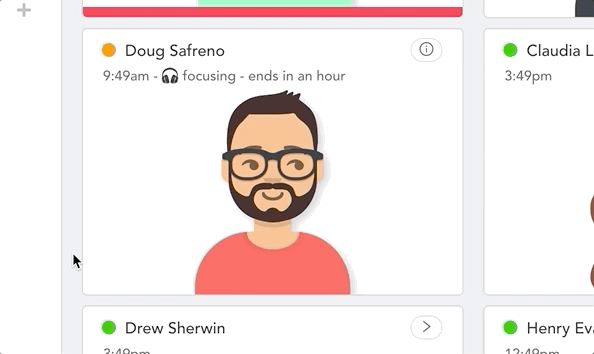
“What Slack did for email, we want to do for video conferencing,” Pragli co-founder Doug Safreno tells me. “Traditional video conferencing is exclusive by design, whereas Pragli is inclusive. Just like in an office, you can see who is talking to who.” That means less time wasted planning meetings, interrupting colleagues who are in flow or waiting for critical responses. Pragli offers the focus that makes remote work productive with the togetherness that keeps everyone sane and in sync.
The idea is to solve the top three problems that Pragli’s extensive interviews and a Buffer/AngelList study discovered workers hate:
- Communication friction
- Loneliness
- Lack of boundaries
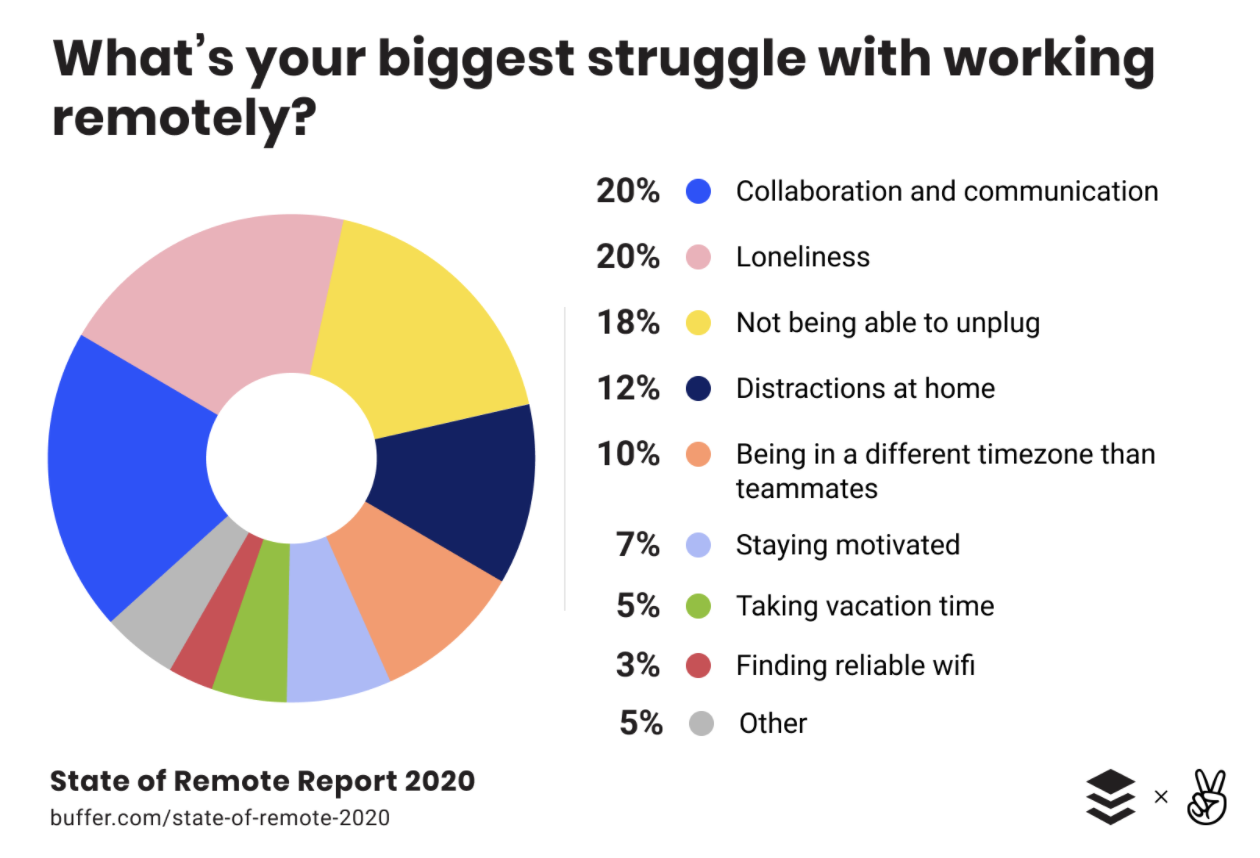
You never have to worry about whether you’re intruding on someone’s meeting, or if it’d be quicker to hash something out on a call instead of vague text. Avatars give remote workers a sense of identity, while the Pragli water cooler provides a temporary place to socialize rather than an endless Slack flood of GIFs. And because you clock in and out of the Pragli office just like a real one, co-workers understand when you’ll reply quickly versus when you’ll respond tomorrow unless there’s an emergency.
“In Pragli, you log into the office in the morning and there’s a clear sense of when I’m working and when I’m not working. Slack doesn’t give you a strong sense if they’re online or offline,” Safreno explains. “Everyone stays online and feels pressured to respond at any time of day.”
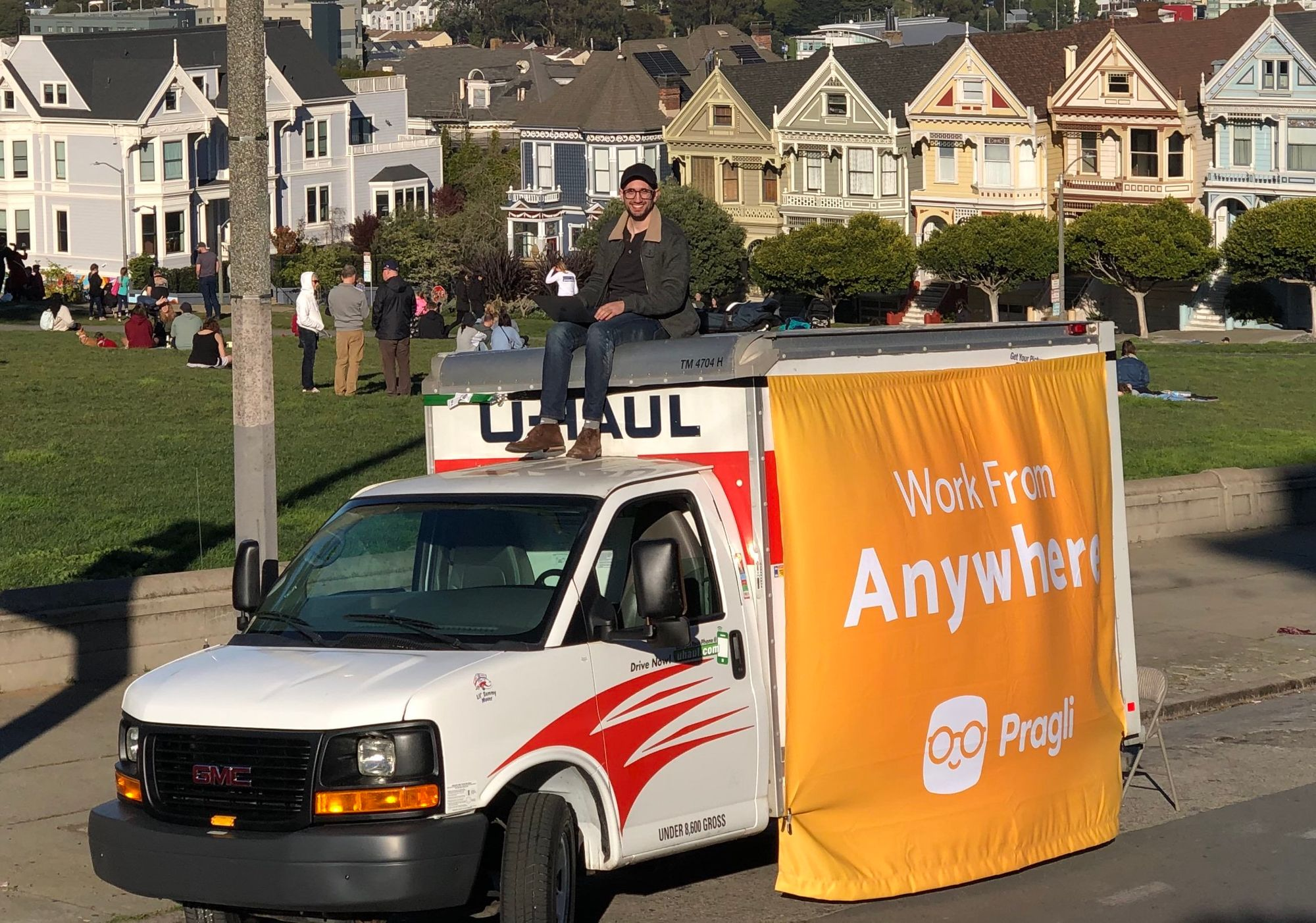
Pragli co-founder Doug Safreno
Safreno and his co-founder Vivek Nair know the feeling first-hand. After both graduating in computer science from Stanford, they built StacksWare to help enterprise software customers avoid overpaying by accurately measuring their usage. But when they sold StacksWare to Avi Networks, they spent two years working remotely for the acquirer. The friction and loneliness quickly crept in.
They’d message someone, not hear back for a while, then go back and forth trying to discuss the problem before eventually scheduling a call. Jumping into synchronous communicating would have been much more efficient. “The loneliness was more subtle, but it built up after the first few weeks,” Safreno recalls. “We simply didn’t socially bond while working remotely as well as in the office. Being lonely was de-motivating, and it negatively affected our productivity.”
The founders interviewed 100 remote engineers, and discovered that outside of scheduled meetings, they only had one audio or video call with co-workers per week. That convinced them to start Pragli a year ago to give work-from-home teams a visual, virtual facsimile of a real office. With no other full-time employees, the founders built and released a beta of Pragli last year. Usage grew 6X in March and is up 20X since January 1.
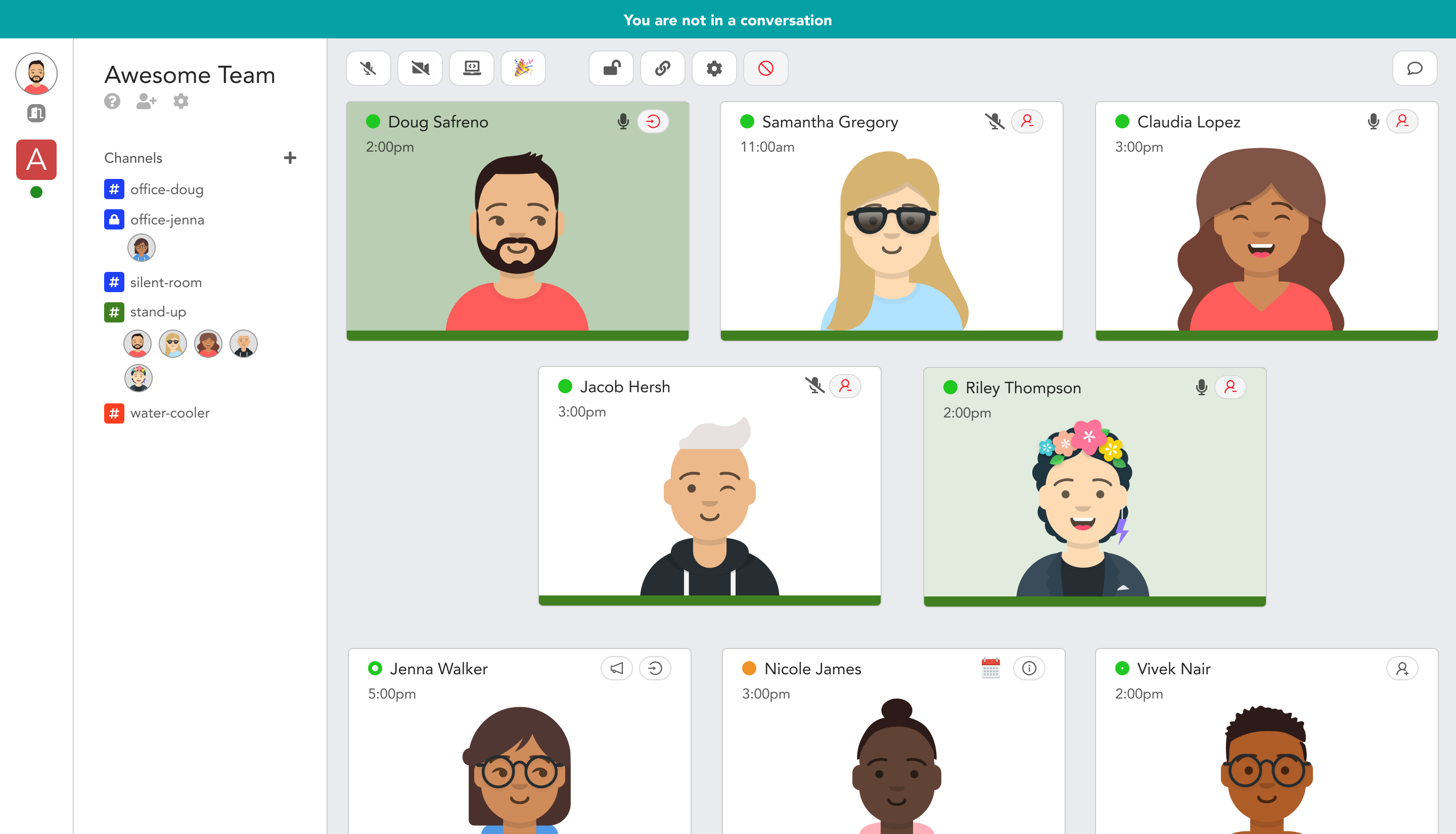
Today Pragli officially launches, and it’s free until June 1. Then it plans to become freemium, with the full experience reserved for companies that pay per user per month. Pragli is also announcing a small pre-seed round today led by K9 Ventures, inspired by the firm’s delight using the product itself.
To get started with Pragi, teammates download the Pragli desktop app and sign in with Google, Microsoft or GitHub. Users then customize their avatar with a wide range of face, hair, skin and clothing options. It can use your mouse and keyboard interaction to show if you’re at your desk or not, or use your webcam to translate occasional snapshots of your facial expressions to your avatar. You can also connect your Spotify and calendar to show you’re listening to music (and might be concentrating), reveal or hide details of your meeting and decide whether people can ask to interrupt you or that you’re totally unavailable.
![]()
From there, you can by audio, video or text communicate with any of your available co-workers. Guests can join conversations via the web and mobile too, though the team is working on a full-fledged app for phones and tablets. Tap on someone and you can instantly talk to them, though their mic stays muted until they respond. Alternatively, you can jump into Slack-esque channels for discussing specific topics or holding recurring meetings. And if you need some down time, you can hang out in the water cooler or trivia game channel, or set a manual “away” message.
Pragli has put a remarkable amount of consideration into how the little office social cues about when to interrupt someone translate online, like if someone’s wearing headphones, in a deep convo already or if they’re chilling in the microkitchen. It’s leagues better than having no idea what someone’s doing on the other side of Slack or what’s going on in a Zoom call. It’s a true virtual office without the clunky VR headset.
“Nothing we’ve tried has delivered the natural, water-cooler-style conversations that we get from Pragli,” says Storj Labs VP of engineering JT Olio. “The ability to switch between ‘rooms’ with screen sharing, video and voice in one app is great. It has really helped us improve transparency across teams. Plus, the avatars are quite charming as well.”
With Microsoft’s lack of social experience, Zoom consumed with its scaling challenges and Slack doubling down on text as it prioritizes Zoom integration over its own visual communication features, there’s plenty of room for Pragli to flourish. Meanwhile, COVID-19 quarantines are turning the whole world toward remote work, and it’s likely to stick afterwards as companies de-emphasize office space and hire more abroad.
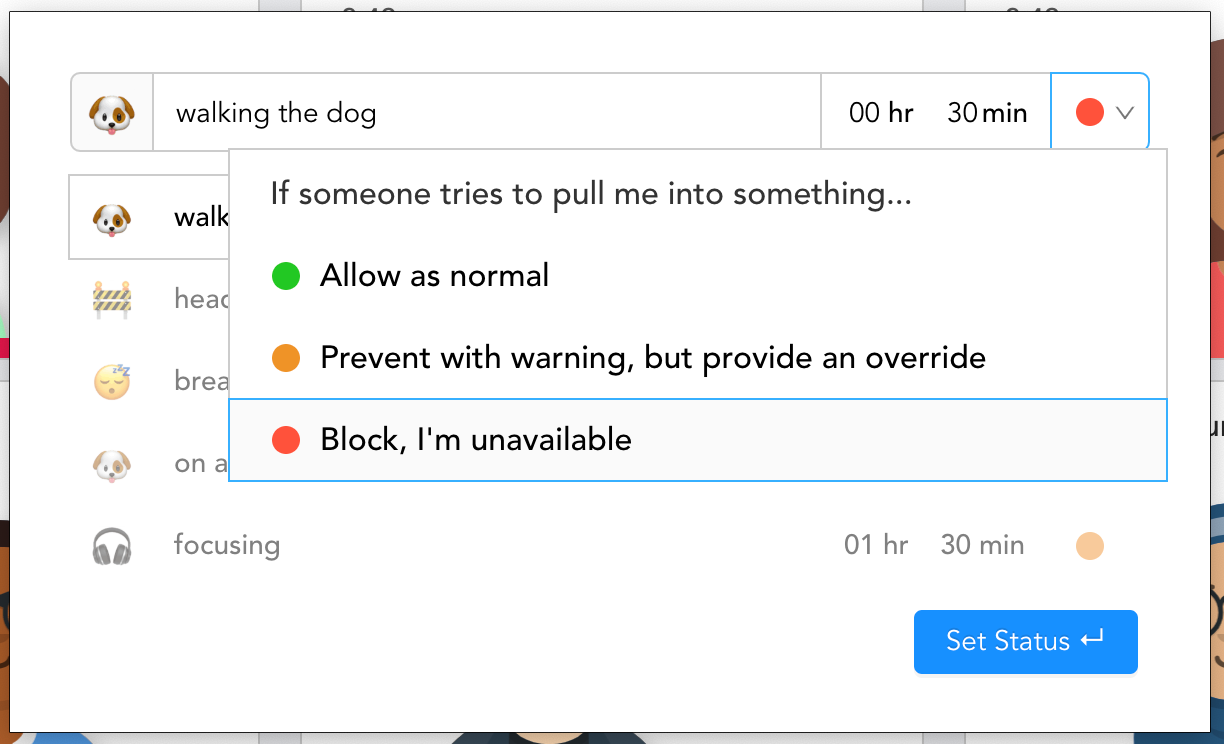
The biggest challenge will be making comprehensible enough to onboard whole teams such a broad product encompassing every communication medium and tons of new behaviors. “How do you build a product that doesn’t feel distracting like Slack but where people can still have the spontaneous conversations that are so important to companies innovating?,” Safreno asks. The Pragli founders are also debating how to encompass mobile without making people feel like the office stalks them after hours.
“Long-term, [Pragli] should be better than being in the office because you don’t actually have to walk around looking for [co-workers], and you get to decide how you’re presented,” Safreno concludes. “We won’t quit, because we want to work remotely for the rest of our lives.”
Powered by WPeMatico
OnePlus redefines its premium approach with the 8 Pro
As recently as a year or two ago, the idea of a $900 starting price for a OnePlus device would have seemed, at best, fanciful. The company built a name for itself with a series of flagship quality devices at a mid-tier price point. It was a smart approach that served the company well, carving a solid niche for itself even amid a saturated and stagnant market.
But as the market has changed, so too has OnePlus. One of the more pronounced signs of the company’s growth over the past half-dozen years is an increasing interest in the higher end of the market. It has been a slow evolution. First the company rethought its longstanding approach of holding off on cutting-edge technologies, and then last year it introduced a Pro tier to its device line.
The latter, in particular, opened the line to a real premium category, and today it delivered on the promise with the introduction of the OnePlus 8 and 8 Pro, starting at $699 and $899, respectively. The Pro comes in two configurations, with 8GB of RAM and 128GB of storage or 12GB/256GB (the same as you’ll find on the standard 8), with the higher end running an extra $100.
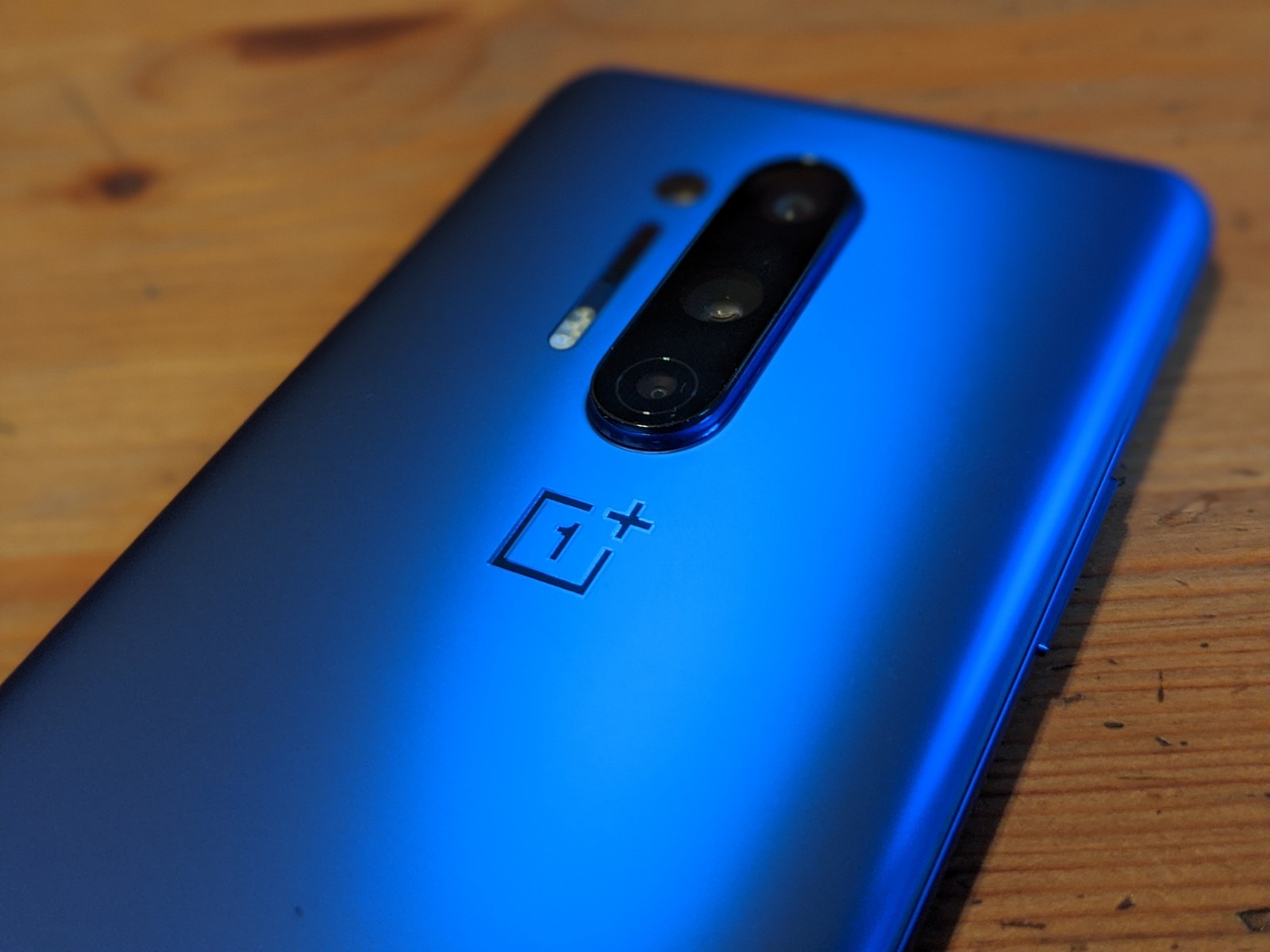
That’s chump change compared to premium devices from the likes of Samsung and Apple, but it’s still a new paradigm from the traditionally budget-minded OnePlus. Of course, you’re going to get a lot for that price — this is OnePlus, after all.
First, there’s 5G. That was one of the trends OnePlus was more than happy to be among the first to jump on. It also was something we spent a lot more time talking about when we were still allowed outside. Which, honestly, makes this as good a time as any to point out that I’ve had the phone in my possession for a while, but am unable to do a proper review due to both my inability to leave the house and some of my own ongoing health issues.

What I will say, however, is that it’s one of the more striking devices I’ve seen in a while, due in no small part to a lovely — if largely unphotographable — blue finish. Up front is a massive 6.78-inch curved QHD+ display coupled with a 120 Hz refresh rate (that can be toggled down to 60Hz to save on battery — which is perfectly fine for most tasks).
In spite of the large screen, it’s still held easily in one hand, courtesy of the elongated 19.8:9 aspect ratio. HDR Boost provides stronger color contrasts, along with 10-bit color for better accuracy. It’s a combination that pops, making for a solid and well-rounded display at a price point that’s plenty competitive with high-end devices.

Around back is an interesting take on the quad-camera design. There’s a 48-megapixel main, 48MP ultra wide, a 3x optical zoom (for a total of an admittedly degraded 30x with help from digital) and a color filter camera. That last one’s a bit of an odd addition with some fairly niche uses, like the ability to add “artistic lighting effects and filters.” Not exactly the most useful application of a fourth rear-facing camera.
The handset is powered by the flagship-ready Snapdragon 865, along with a solid 4510 mAh battery that charges to 50% in less than half an hour. There are a handful of OnePlus’s customary software add-ons as well, via the latest version of OxygenOS, including a new Dark Theme and various other visual touches.
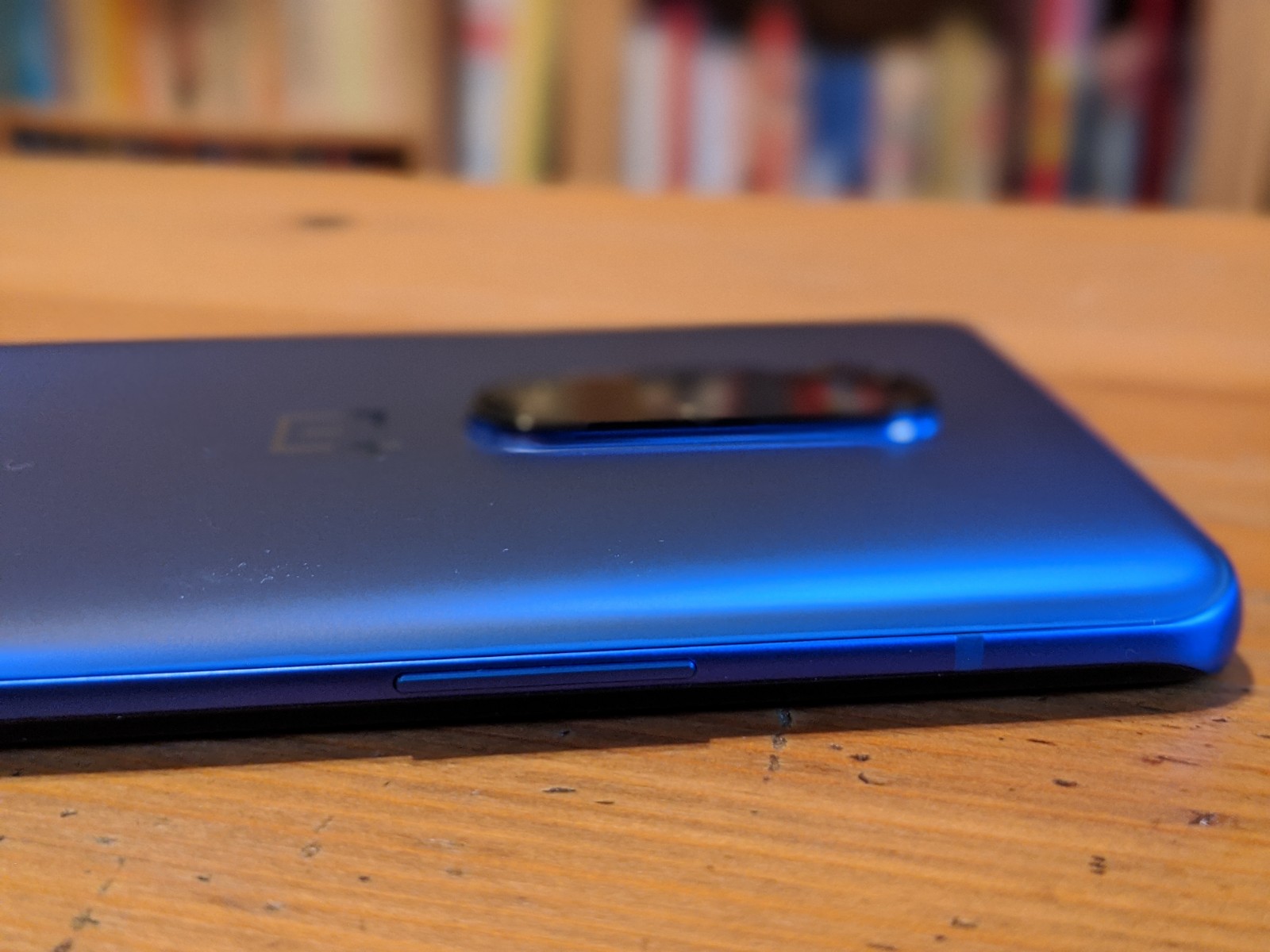
It adds up to a handset that still feels like a bit of a bargain, in spite of being OnePlus’s most expensive to date. It goes on sale April 29 through OnePlus, carrier sites and Amazon. The $699 OnePlus 8 will be available the same day.
Powered by WPeMatico
Facebook launches an experimental app for messaging close friends via Apple Watch
Facebook’s internal R&D group has today launched a new app that lets you keep up with your close friends via your Apple Watch. The app is called Kit, or Keep in Touch, and works using a combination of QR codes and Facebook’s existing Messenger service.
According to Kit’s App Store description, you get started with the app by first scanning a QR code on your watch or by entering in an access code at fb.com/devices. You then select the Messenger contact you want to stay in touch with using Kit.
The app allows you to send a variety of messages with just one tap, including voice recordings, emoji, location sharing, scribbles and even dictation input — similar to how using iMessage from your Apple Watch works today. However, these messages are being sent over Facebook’s own Messenger service, not SMS or iMessage.
The new app also allows you to receive and respond to notifications and read your contact’s messages to you.

The idea behind the app is to allow users to stay in touch without having to pick up their phone, the App Store description explains.
While Facebook’s Messenger already offers support for Apple Watch, Kit is focused more on keeping up with close contacts only– a significant other, best friend, or family member, for example. That allows it to offer a different user interface and experience from Messenger on Apple Watch, where you have to navigate on a tiny screen to read and respond to your messages.
Kit is the latest from Facebook’s internal R&D division, NPE Team, which tests out new app concepts and rapidly iterates. So far, the NPE Team has put out a variety of new social apps like meme creator Whale, conversational app Bump, music app Aux, video app Hobbi, and most recently, Tuned, an app for couples. But only a few remain available today, as Facebook had said previously that the NPE Team apps that don’t find an audience will be quickly shut down.
To date, the NPE Team apps have launched new social experiences that weren’t tied to Facebook’s existing products. Kit, however, ties into Messenger — a move that could help it gain more of an audience, as it can tap into Messenger’s over a billion users. In addition, Kit could prove especially useful in the COVID-19 era, as people are trying not to touch their smartphones while out in public and wearing gloves. Instead, they could respond to critical messages from their close friends or family over Kit, without having to use their phone.
Kit is also notable for being the first of Facebook’s NPE Team apps to launch on Apple Watch.
Facebook doesn’t typically comment on its NPE Team experiments, and will instead point back to its original announcement that said availability would depend on the app.
According to data from Apptopia, the app hasn’t ranked yet on the App Store charts, as it’s still new. It appears to be only offered in Canada, at present.
Kit is a free download for iOS, but is for Apple Watch only.
Powered by WPeMatico






